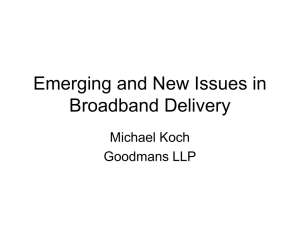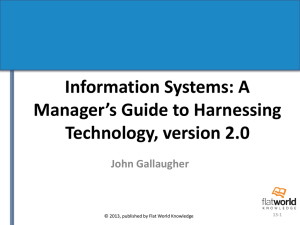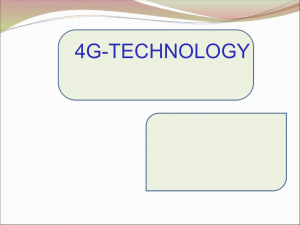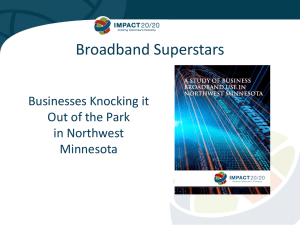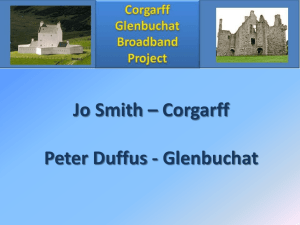(Next Generation Internet).
advertisement
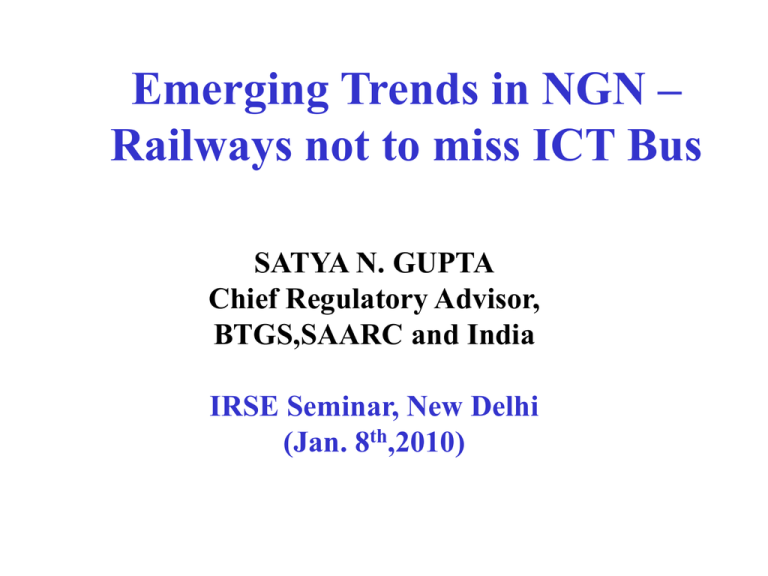
Emerging Trends in NGN – Railways not to miss ICT Bus SATYA N. GUPTA Chief Regulatory Advisor, BTGS,SAARC and India IRSE Seminar, New Delhi (Jan. 8th,2010) AGENDA • Emerging Technological Developments – Dominance of Wireless and IP. • Next Generation Network (NGN) Ecosystem. • Mega Technology Trends. • Broadband Converged Network –NG BCN. • Opportunity for Indian Railways. Starting Quotes “ Solid state LED technology will make the light bulb a thing of the past. Voice Over Internet Protocol will spell a revolution in Telephony. Even more powerful microchips and ever faster chip-to-chip interfaces will allow for new applications in anything from systems management to cinema -quality computer games.” - Joshua Livestro in techcentralstation.com “The future of lighting --OLED--” “The future of telephony --VOIP--” “The future of networks --NGN--” Technology Development Trends • Increased speed and density of Integrated Circuits (Moores Law). • Enhanced Transmission capacities on Optic Fiber Networks and Flexibility (Gilders Law). • Distributed and Open Platform-based Communication Software (APIs). • Capacity Growth and innovative Application Services on Wireless. (Coopers Law) • Emergence of Next-Generation Networks (IPbased) offering QOS for real-time services. • Ubiquity of networks through RFID & IPv6 (Next Generation Internet). 1.Evolution of VOIP(Voice Over Internet Protocol) • IP-based Networks are establishing themselves. However, Circuit-Switching based Networks still delivering the goods. • Packet Networks gone beyond ‘Best-Effort’ tag and countered the limitation of security and reliability. • Cost advantage and transmission efficiency of VOIP leading to ‘Death of Distance’. • Media Gateway (Soft-Switches) enabling coexistence of circuit-switched networks and packetswitched networks in a seamless manner. IP OPTIONS FOR LONG DISTANCE TELEPHONY 1 PSTN Long Distance Network (TDM) 2 VOIP Gateway Managed VOIP backbon e VOIP Gateway 3 PST N Customer Premises Equipment Local Exchange Internet Telephony Service Providers Node Public Interne t PSTN Internet Telephony Service Providers Node Local Exchange Customer Premises Equipment 2.Evolution of Alternate Last Mile Technologies • Use of Coaxial Cable for Telecom Services (Cable TV Network for Broadband and telephony local loop). • Use of DSL technology on traditional Copper Loops. • Wireless Access Service for Fixed and Mobile communication. • VSAT-based Access in remote areas. • Power line based Access (BPL). • Free Space Optics (FSO). 3.Technology Alternatives for Wireline Broadband Evolution of Wireline Technologies i) Use of Digital Subscriber Loop (DSL) technology on traditional Copper Loops (DIY, Franchising, Shared unbundling, Bit stream access) – Asymmetric DSL (ADSL) – 1 Mbps upstream/ 8 Mbps downstream, 3 Km – ADSL (G.Lite) – Splitter free, 512 Kbps upstream/ 1.5 Mbps downstream, 5.4 km – Symmetrical DSL – 1.5 Mbps, 3 Km – Single pair High-speed DSL (SHDSL) – 2.3 Mbps symmetric, 3 Km – ADSL 2, ADSL 2 + – 8/24 Mbps, 1.5 Km – Very high Data Rate DSL (VDSL) – 52 Mbps, 1.5 Km Broadband over copper loop (DSL) Local PSTN Exchange Customer Premises Twisted Pair Copper Loop TV [video] Phone [voice] DSL Modem LEX PC [data] DSLAM CDN Content Delivery Network Internet ii) Cable TV Networks for Broadband access – Broadband over cable TV accounts for 74% of total connections in US, and 55% in Canada – 55 million cable homes in India, but infrastructure can not support bidirectional communication and requires upgrade – Regulatory environment, via an ISP license, allows this with some MSO’s and operators already doing so – For advances to occur, better organization of the industry needed to be executed – Cable operators will need to adopt innovative business models to compete in converged environment • Possible to provide upgraded entertainment services such as interactive digital TV, pay-per-view, video on demand and time-shifted TV • Benefits operators with significantly higher ARPU and better customer retention • To start with Cable TV network which is uni-directional can be used for downloading, the uplink to be conventional narrow band like dialup/ ISDN/ RADIO – Operators need training to create awareness about utility of their networks and understanding of the investments required, returns possible, and technical aspects iii) Fibre Optic Cable Technologies –Fiber To The Curb (FTTC) – by existing operators –Fiber To The Home (FTTH) – Fibre in last mile to deliver converged services –Hybrid Fiber Coaxial (HFC) – by Cable TV operators –Metro Ethernet (Fibre based) – extending the range of LAN –GPON (Gigabit - Passive Optical Network) – triple play over TDM –(No limitation of distance or throughput speeds) iv) Broadband over Powerline (BPL) Technologies –Use of existing domestic power connections for sending data –Throughput in the range of 1 MHz (4 – 6 Mbps) –Ideal for rural areas where telecom / cable TV infrastructure may not be there v) Metro Ethernet Networks –Use of Ethernet beyond LAN –Use of high-speed access using hybrid fiber/ copper based Ethernet technology –Power over Ethernet (POE) 4.Mobile Technologies Trends • GPRS,EDGE,802.11(WLAN,Wi-Fi), 802.16(Wimax),PTT,Bluetooth,UWB, 3G- Already Available. • B3G, 802.16e (Mobile WiMAX), OFDMA, 802.16m, 802.20 (WWAN,MBWA), All-IP cellular networks- Emerging out. • Human Area Network (HAN) associated with body/ clothingBecoming a possibility. • Fixed Mobile Convergence(FMC) leading to interoperability of handsets for any type of access – Quad Mode Multi Band handsets. (WiFi, Wimax, GSM, CDMA) • Software Defined Radios (SDR) – Multi-Functional, Multiservice, Multiprotocol, Multiband, Multimode (Universal) Radios. • Cognitive Radio(CR)/ Intelligent Radios Broadband Wireless Access (BWA) Technologies Technology Max Throughput Frequency Bands Typical Range Application WiFi (802.11x) 54 Mbps/ 11 Mbps 2.4 G, 5.1 G 100-400 mtrs WLAN WiMax (802.16x) 70 Mbps 700 MHz, 2.3 G, 2.5 G, 3.5 G, 5 G Up to 50 Kms WWAN Mobi-Fi (802.20)` 40 Mbps 2.4, 3.5, 5.5 G 8-10 Kms Mobile Broadband CorDect 70 Kbps 1900 MHz 10-15 Kms WWAN WCDMA/ 3G 2.0 Mbps 1900-2100 MHz Unlimited (Cellular) Mobile Broadband EV-DO,HSPDA 2.4 Mbps (shared) 450,,900,1800 MHz Unlimited (Cellular) Mobile Broadband EDGE 230 Kbps 900,1800 MHz Unlimited (Cellular) Mobile Internet GPRS 58 Kbps 900,1800 MHz Unlimited (Cellular) Mobile Internet CDMA (2000-1X) 144 Kbps (shared) 450,,900,1800 MHz Unlimited (Cellular) Mobile Internet FSO 100 Mbps to few Gbps Light Wave Few Kms CAN Microwave radio (MMDS/ LMDS) Few Mbps 3.5 G – 31 G 50 Kms + MAN VSAT 20 Mbps 4 G – 11 G Unlimited GAN (Remote Area) Wireless USB 2.0 480 Mbps 2.4 G 10 mtrs VAN Bluetooth(802.15.1 3 Mbps 2.4 G 1-10 mtrs PAN Infrared 16 Mbps Light Wave 1-5 meter BAN ZigBee/ UWB 200Kbps/400-500Gbps 2.5G-5.8G 1-100 mtrs PAN RFID Few Kbps 2.4 G,900Mhz Few Inches Contact-less Detection BWA Technology Evolution- 3G and beyond UMTS (3G) HSPA EVDO (3G) 802.16 a/d 802.16e IMTAdv(4G) Bandwidth 5 MHz 5 MHz 1.25 MHz 1.25-20 MHz 1.25-20 Mhz 1.25-20 MHz Typical Spectrum 1.9-2.1 GHz 1.9-2.1 GHz 450-1900 MHz 2.3-5.8 GHz 2.3-5.8 GHz IMT (3G)Bands Downlink Peak Rate 0.4 bps/Hz 2.9 bps/Hz 2.5 bps/Hz 3.2 bps/Hz 3.2 bps/Hz 15bps/Hz Uplink Peak Rate 0.4 bps/Hz 0.4 bps/Hz 1.4 bps/Hz 2.4 bps/Hz 2.4 bps/Hz 6.75 bps/Hz 0.1 bps/Hz Ave DL Thr oughput 0.7 bps/Hz 0.9 bps/Hz 0.53 bps/Hz 0.75 bps/Hz - Latency 150 ms 100 ms 100 ms 100 ms 100 ms < 50 ms Flat IP Support No No No Yes Yes Yes Mobility Full Full Full Fixed Limited Full 5.Broadband using DTH for Receiveonly Internet CUSTOMER PREMISES EQUIPMENT BROADCAST CHANNEL RECEIVE ONLY SIGNAL CUSTOMERS RECIVING SET 512 kbps Inbound DTH PROVIDERS TRANSMITTER OUTBOUND COMBINED SIGNAL DTH Service Provider Hub OUTWARD DIALUP EQUIPMENT Outbound Channel (Radio, ISDN, Dial up etc.) - International Internet Cloud Speed of outbound channel is -generally between 10 to 20% of inbound channel 64 – 128 kbps Internet Service Provider 6.Broadband Services Trends • High speed Internet access (death of World-WideWait) – Still the killer application for Broadband in India • Video-On Demand, Interactive TV, IPTV, PPV, Time Shifted TV, Videoconferencing,telepresence, (Multimedia over Broadband) • Triple Play (data, voice, video) – One stop solution • IP-VPN (low cost connectivity) • EOIP • Interactive Gaming, HDTV, Work- From- Home • 4 e’s (e-Governance, e-Learning, e-Health, eCommerce) VSAT INTERNET KIOSK/ HOME Ethernet FTTC >2 Mbps 512 Kbps2 Mbps 256 Kbps4 Mbps DSL Metro Ethernet Cordect INTERNET (CONNECTIONLESS) PSTN (Connection oriented) 70 Kbps WLL CDMA SWITCHED TELEPHONE/DATA SERVICE (FR/ATM) 144 Kbps – 2 Mbps 3G Cellular Mobile HANDSET Cable TV Network (Shared) M-COMM SERVER Hotspots Network (WISP) CM Broadband through Cable TV 64-384 Kbps E-COMM SERVER ROUTED (TCP/IP) PLMN GSM/ GPRS/ EDGE 384 Kbps128 Kbps2 Mbps 1.5 Mbps WAP ENABLED/ GPRS/ EDGE HOME SHOPPING SERVER (E-COMM) VIDEO SERVER Wireless Broadband Broadband Access through DTH (Wi-Fi, Wi-Max) BUSINESS VOICE, DATA & VIDEO ON SAME PLATFORM Broadband Access in India- Technology-Neutrality (making use of existing infrastructure & wireless) 7.Trend Towards Convergence – NGN • Evolving Networks leading to Convergence of Voice, Data & Video services on a common infrastructure resulting into cost saving and performance improvements as well as leading to new avenues for revenue generation. • Convergence of Telecom, Broadcast and Internet leading to Multimedia services. • Evolving NGNs and 21CNs capable of guaranteed QOS and high level of Security, Reliability and Flexibility. • Emergence of single “Information Plug” (TriplePlay). • Customers aspiration – Better, Faster, Cheaper 8.What is NGN Ecosystem? (From Layman’s point of view) • Next Generation Services – Converged (quad-play-voice, data, video, mobile) • Next Generation Access – High speed (Broadband) IP based connectivity (ADSL,VDSL,Wi-Max,Cable TV, FTTH, PLC) • Next Generation Transport – Carrier Ethernet, IP-MPLS • Next Generation Architecture – Service oriented (SOA), layered (transport, control, application) • Next Generation Mobile – 3G+ (B3G) • Next Generation Internet – IPv6 • Next Generation Interconnect – Capacity and Quality based • Next Generation Licensing – Unified • Next Generation Regulation - Converged Next Generation Networks – Technology Evolution Present Day Networks Next Generation Networks (NGN) Internet Integrated Services Over IP Gateways Wireless PSTN Evolving towards All IP Communications NGN v/s PSTN Components PSTN Switch NGN Components Call Control Application & Service Control Server Switching IP Routing Interfaces SDH Transport with Overlay packets for data Gateways Common IP MPLS Transport NGN – a layered architecture distributing intelligence Control Bearer Application Layer Application Services Internet Service Control Layer Softswitch Control IP Service Switching Transport Layer (core and access) Media Gateways PSTN Broadband Access Multiservice Packet Switching RAS X DSLAM GbE Frame/ ATM ACCESS NETWORK X Metro Optical X X X X National Optical X X CORE NETWORKS CPE Wireless X X Typical NGN architecture 9.Emerging NGN Services – EOIP Voice over IP Unified Messaging BB - High Speed Internet Primary line Content Delivery PC to Phone Second line Games Phone to PC IP Centrex usage Downloads (MP3) IP VPN (data) Voice VPN BW on-demand IP Centrex Video on demand QOS on demand IP Offload TV on demand Quad play 3G & beyond applications Distance learning Cinema of the future Multimedia Conferencing Telepresence Remote lab Instant messaging presence management MMS on fixed network Location Based Services (LBS) FMC (Fixed Mobile Con.) 10.Next Generation Internet (IPv6) IPv6 is the next generation Internet protocol with improvement over the age old initial version IPv4 (since 1981). It has capacity to expand the available address space on the Internet enormously, using 128 bits vis-à-vis 32 bits of IPv4. Address limit of IPv4 is of the order of 4 Billions, while that for IPv6 is 3X1039. (3000 Billion Billion Billion Billion). Major weaknesses of IPv4 • Limited Address Space as addresses are 32 bits (4 bytes) in length. • No identification of packet flow for QoS handling by routers. • Address configuration either manually or through DHCP (Dynamic Host Configuration Protocol). • Security and mobility additional efforts. support needs Advantages of IPv6 •A larger address space and flexible addressing scheme •Efficient and Hierarchical Addressing Routing with Streamlined header format and •Inherent support for secure communications •The ability to allow differentiated services •Better support for mobility •Auto-Configuration capability supporting ‘plug and play’ 11.Spectrum Utilization Trends • Radio Spectrum availability is key to the success of exploitation of new radio technology trends. • Being a limited resource, innovative evolution and management techniques required for optimum utilization. • Usage of Multi-Layer, Hierarchical frequency-reuse based on macro, micro and pico, femto cells, Cell splitting, Synchronous Frequency Hopping, Narrow banding etc. • Use of Adaptive, Intelligent Antenna Array and Scattering. • Enhancing the information carrying capacity of radio spectrum by Multi-level Modulation, Compression, AMR Coding, DTX, DSI ,OFDMA etc. to move towards Shannon’s Limit. 12.Mega Technology Trends • Core Infrastructure – Robust, Agile, Cheap, Invisible • Network – Packetised, Secure, Reliable, Broadband, Ubiquitous, Service -oriented • Devices – Always-On, Connected, Smart, Converged (IAD) • Application Development – Fast, Open, DIY Future Dominant Technologies Backbone:- Optic Fiber (Carrier Ethernet) Access:- Wireless Based (4G, Wi-Fi, Wi-Max, VSAT, FSO), xDSL Optic Fibre:- DWDM, Optical Cross Connect, Optical Switch and Router Radio:- Spread Spectrum, SDR (Software Definable Radio), CR Modulation:-Multipoint QAM Multiplexing:-OFDM Switching:- Packet Switching (IP) Addressing:- IPv6, E.NUM Customer Premises Equipment:- Converged (IAD), Triple play Chips: - Supercomputer/ System on a chip (SOC) 14.Next Generation Broadband Converged Network (NG BcN) “Next generation network(NGN) which provides seamless converged services from Telecom, Internet & Broadcasting infrastructure at any time, anywhere to anywhere, from any device to any device as per the wish of Customers.” Converged Services Open Application Interface QOS Broadband IP Inter-operatability Wire + Wireless Voice + Data Telecom + Broadcasting ‘Any Media’ ‘Any Mode’ ‘Any Service’ 15. ICT Opportunity for Indian Railways • 1000 Towers- Share Infra, Create Rlys. Wireless Corridor ( Rlys. dedicated spectrum band) • 5 Lakhs Copper Loops- Broadband, Triple Play • 500 Exchanges- IP DSLAM POP • 40,000 Km OFC- Packetise,Lease-out and Collaborate • 10,000 Km Cu-Quad- Digitalise • 7000 Railway Stations- Hot Spots, E-services Outlets • 20,000 KM of Digital radio (34Mb)- Packetise(100Mb) • Use Innovative Green tech.- Earn Carbon Credits • 15 Million daily passengers and 1.5 million employeesCaptive Customer Base, Smart Cards,Service bundling • Popular Railnet- Leap frog to Next Generation-IPV6 • Become ATN ( Alternate Telecom Network)- A Multimedia Super Highway with Rural Access to contribute towards Nation building ( Bharat- Nirman). THANK YOU Satya N.Gupta Chief Regulatory Advisor, BT GS,SAARC and India E-Mail satyen.gupta@bt.com, sngupta57@yahoo.com
